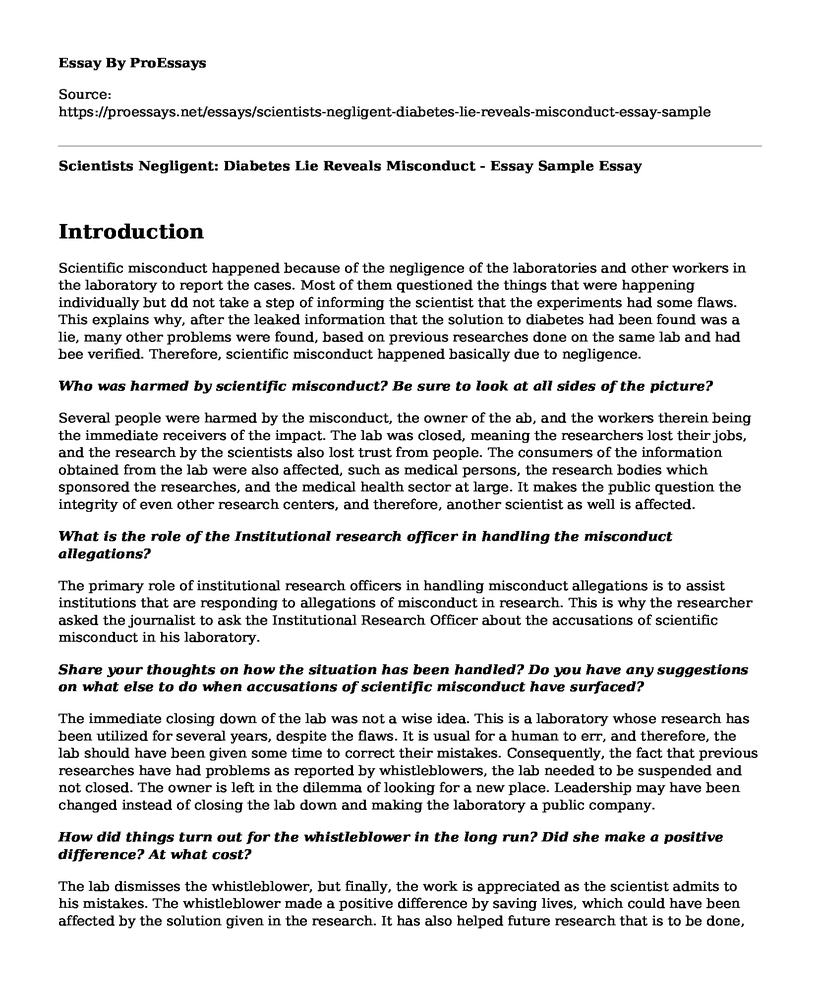Introduction
Scientific misconduct happened because of the negligence of the laboratories and other workers in the laboratory to report the cases. Most of them questioned the things that were happening individually but dd not take a step of informing the scientist that the experiments had some flaws. This explains why, after the leaked information that the solution to diabetes had been found was a lie, many other problems were found, based on previous researches done on the same lab and had bee verified. Therefore, scientific misconduct happened basically due to negligence.
Who was harmed by scientific misconduct? Be sure to look at all sides of the picture?
Several people were harmed by the misconduct, the owner of the ab, and the workers therein being the immediate receivers of the impact. The lab was closed, meaning the researchers lost their jobs, and the research by the scientists also lost trust from people. The consumers of the information obtained from the lab were also affected, such as medical persons, the research bodies which sponsored the researches, and the medical health sector at large. It makes the public question the integrity of even other research centers, and therefore, another scientist as well is affected.
What is the role of the Institutional research officer in handling the misconduct allegations?
The primary role of institutional research officers in handling misconduct allegations is to assist institutions that are responding to allegations of misconduct in research. This is why the researcher asked the journalist to ask the Institutional Research Officer about the accusations of scientific misconduct in his laboratory.
Share your thoughts on how the situation has been handled? Do you have any suggestions on what else to do when accusations of scientific misconduct have surfaced?
The immediate closing down of the lab was not a wise idea. This is a laboratory whose research has been utilized for several years, despite the flaws. It is usual for a human to err, and therefore, the lab should have been given some time to correct their mistakes. Consequently, the fact that previous researches have had problems as reported by whistleblowers, the lab needed to be suspended and not closed. The owner is left in the dilemma of looking for a new place. Leadership may have been changed instead of closing the lab down and making the laboratory a public company.
How did things turn out for the whistleblower in the long run? Did she make a positive difference? At what cost?
The lab dismisses the whistleblower, but finally, the work is appreciated as the scientist admits to his mistakes. The whistleblower made a positive difference by saving lives, which could have been affected by the solution given in the research. It has also helped future research that is to be done, to be honest, and of high integrity. This is because the investigation is handling people's lives and, therefore, needs to be accurate. It has taught technicians that, they also have a role to play, by reporting mistakes they find to the responsible parties. That is why the researcher, in the end, advises that it is the responsibility of everyone to identify errors in a system and correct rather than blindly following rules as they are told.
Cite this page
Scientists Negligent: Diabetes Lie Reveals Misconduct - Essay Sample. (2023, Aug 01). Retrieved from https://proessays.net/essays/scientists-negligent-diabetes-lie-reveals-misconduct-essay-sample
If you are the original author of this essay and no longer wish to have it published on the ProEssays website, please click below to request its removal:
- Nursing Ethics Theories Paper Example
- Benefits of Medical Marijuana and Its Legality
- Concept Analysis of Pain - Research Paper
- Essay on Hematologist-Family Nurse Practitioner Collaboration: A Must-Have Skill
- The Essential Role of Nursing in Quality Healthcare Services - Essay Sample
- Essay Sample on Nightingale Comm. Hosp. Accreditation: Quality, Safety & Cost Efficiency
- Essay Example on Victoria's Secret: Pioneering US Lingerie, Clothing & Beauty Retailer







